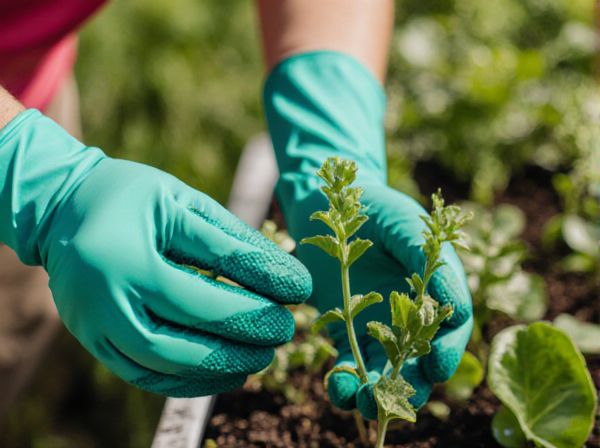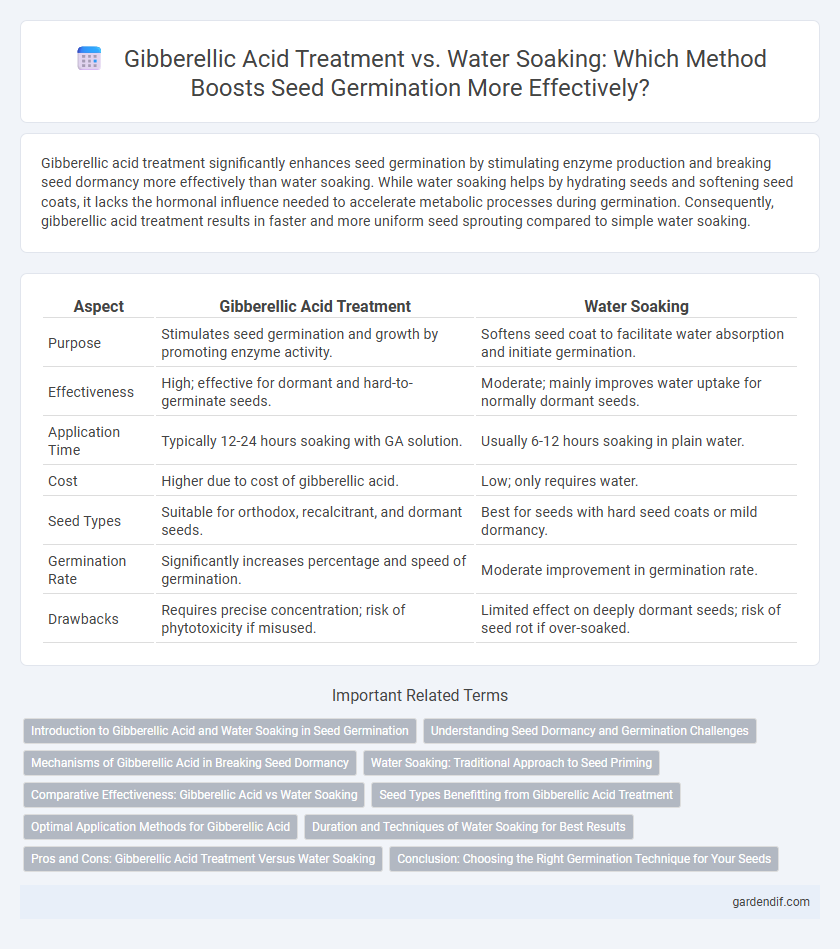
Gibberellic Acid Treatment vs Water Soaking Illustration
Gibberellic acid treatment significantly enhances seed germination by stimulating enzyme production and breaking seed dormancy more effectively than water soaking. While water soaking helps by hydrating seeds and softening seed coats, it lacks the hormonal influence needed to accelerate metabolic processes during germination. Consequently, gibberellic acid treatment results in faster and more uniform seed sprouting compared to simple water soaking.
Table of Comparison
| Aspect | Gibberellic Acid Treatment | Water Soaking |
|---|---|---|
| Purpose | Stimulates seed germination and growth by promoting enzyme activity. | Softens seed coat to facilitate water absorption and initiate germination. |
| Effectiveness | High; effective for dormant and hard-to-germinate seeds. | Moderate; mainly improves water uptake for normally dormant seeds. |
| Application Time | Typically 12-24 hours soaking with GA solution. | Usually 6-12 hours soaking in plain water. |
| Cost | Higher due to cost of gibberellic acid. | Low; only requires water. |
| Seed Types | Suitable for orthodox, recalcitrant, and dormant seeds. | Best for seeds with hard seed coats or mild dormancy. |
| Germination Rate | Significantly increases percentage and speed of germination. | Moderate improvement in germination rate. |
| Drawbacks | Requires precise concentration; risk of phytotoxicity if misused. | Limited effect on deeply dormant seeds; risk of seed rot if over-soaked. |
Introduction to Gibberellic Acid and Water Soaking in Seed Germination
Gibberellic acid, a plant hormone, plays a crucial role in breaking seed dormancy and promoting germination by stimulating enzyme production that mobilizes stored nutrients. Water soaking is a traditional seed treatment that softens seed coats, enhancing water uptake and initiating metabolic processes essential for germination. Comparing gibberellic acid treatment to water soaking reveals gibberellic acid's targeted hormonal action, often resulting in faster and more uniform germination rates.
Understanding Seed Dormancy and Germination Challenges
Gibberellic acid treatment effectively breaks seed dormancy by stimulating enzymes that weaken the seed coat and promote embryo growth, making it a superior method compared to water soaking for challenging seeds. Water soaking primarily hydrates seeds but often fails to overcome physiological dormancy, limiting germination rates in species with complex dormancy mechanisms. Understanding the hormonal regulation involved in dormancy enables targeted treatments like gibberellic acid to enhance germination success in agricultural and horticultural practices.
Mechanisms of Gibberellic Acid in Breaking Seed Dormancy
Gibberellic acid (GA) accelerates seed germination by stimulating the synthesis of hydrolytic enzymes that degrade the seed coat and mobilize stored nutrients, overcoming dormancy mechanisms. Unlike water soaking, which primarily softens the seed coat through hydration, GA treatment directly activates gene expression related to embryo growth and growth hormone signaling pathways. This hormonal regulation triggers metabolic changes that break physiological dormancy more effectively than mere water imbibition.
Water Soaking: Traditional Approach to Seed Priming
Water soaking is a traditional seed priming method that involves immersing seeds in water to enhance germination speed and uniformity by activating enzymatic processes and softening seed coats. This hydrating technique improves water uptake and physiological readiness, leading to higher germination rates compared to untreated seeds. While gibberellic acid treatment accelerates growth hormones synthesis, water soaking remains a cost-effective, simple approach widely used in agricultural practices for seed vigor improvement.
Comparative Effectiveness: Gibberellic Acid vs Water Soaking
Gibberellic acid treatment significantly accelerates seed germination by enhancing enzyme activity and cell elongation compared to water soaking, which primarily softens the seed coat. Studies reveal that seeds treated with gibberellic acid reach higher germination rates in shorter periods, with increased seedling vigor and uniformity. Water soaking, while beneficial for breaking dormancy in some species, generally offers lower effectiveness and slower germination progression than gibberellic acid applications.
Seed Types Benefitting from Gibberellic Acid Treatment
Gibberellic acid treatment significantly enhances germination rates in seeds with physical dormancy, such as lettuce, cabbage, and several leguminous species, by breaking dormancy and promoting embryo growth. In contrast, water soaking primarily benefits seeds with hard seed coats, like beans and peas, by softening the coat but does not alter internal physiological dormancy. Seeds with physiological dormancy, including some cereal grains like barley and wheat, respond more effectively to gibberellic acid treatment, which stimulates enzymatic activities essential for germination.
Optimal Application Methods for Gibberellic Acid
Gibberellic acid treatment enhances seed germination significantly more than water soaking by accelerating enzyme activity and embryo growth. Optimal application methods include seed priming with a 100-200 ppm GA3 solution for 12-24 hours or foliar spraying during early seedling stages to maximize hormone absorption and efficacy. Precise timing and concentration of gibberellic acid ensure improved germination rates, seedling vigor, and uniform growth compared to water soaking alone.
Duration and Techniques of Water Soaking for Best Results
Germination efficacy varies significantly between Gibberellic Acid (GA3) treatment and water soaking, with water soaking duration typically ranging from 12 to 48 hours to optimize seed hydration and enzymatic activation. Techniques such as intermittent soaking or soaking combined with aeration improve oxygen availability, enhancing seed respiration and uniform germination. Precise control over soaking time is crucial, as prolonged immersion beyond optimal duration can cause seed deterioration or anaerobic stress, reducing germination rates.
Pros and Cons: Gibberellic Acid Treatment Versus Water Soaking
Gibberellic acid treatment significantly enhances seed germination rates and uniformity by stimulating enzymatic activity and breaking seed dormancy, but it can be costly and may require precise concentration control to avoid phytotoxicity. Water soaking is a simple, cost-effective method that softens seed coats and improves imbibition, though it may result in uneven germination and increased susceptibility to fungal infections. Choosing between gibberellic acid and water soaking depends on species-specific seed dormancy and resource availability, balancing efficacy with practicality.
Conclusion: Choosing the Right Germination Technique for Your Seeds
Gibberellic acid treatment significantly accelerates seed germination by stimulating enzymatic activity and breaking dormancy, making it ideal for hard-to-germinate or dormant seeds. Water soaking, while simpler and cost-effective, primarily enhances hydration but lacks the biochemical stimulation provided by gibberellic acid. Selecting the appropriate method depends on seed type and desired germination speed, with gibberellic acid treatment preferred for commercial or research applications requiring rapid and uniform germination.
Gibberellic Acid Treatment vs Water Soaking Infographic

 gardendif.com
gardendif.com